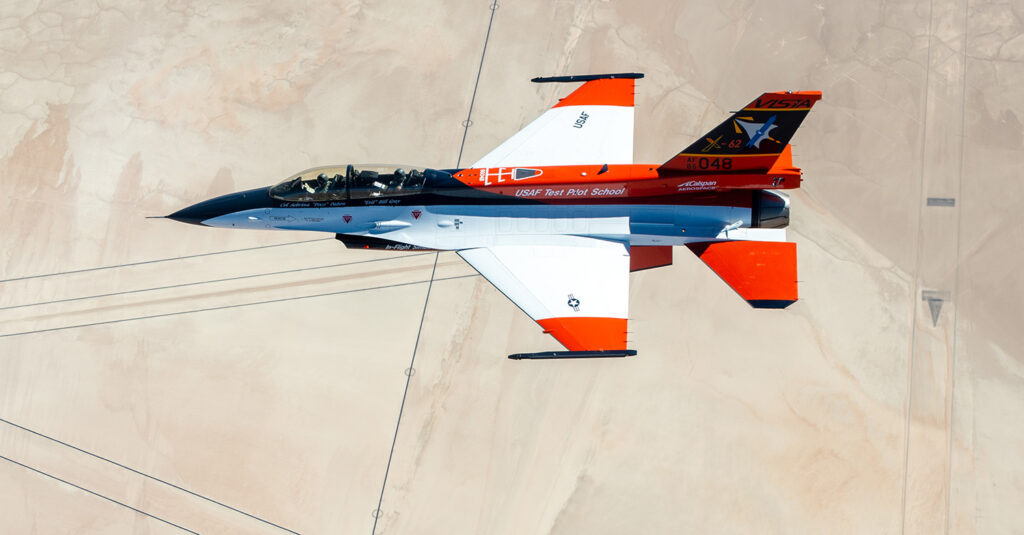Everybody knows the A-10 can bring the pain to ground targets like few aircraft in history, but the aircraft’s tight turn radius and powerful gun can actually make it a force to be reckoned with in a dogfight too.
The A-10 Thunderbolt II, more commonly known as the Warthog, is a legendary air support platform that has earned its reputation as the infantryman’s favorite aircraft throughout decades of combat operations… but the Air Force knows that a near-peer fight against an enemy with real airpower will mean there’s a chance A-10s may find themselves stuck in some fights they aren’t supposed to win. That’s why the Air Force Weapons School starts its A-10 curriculum with Basic Fighter Maneuvers.
While Basic Fighter Maneuvers are usually abbreviated in the aviation world to simply “BFM,” those of us who earn a living outside the cockpit call this kind of combat something different: a dogfight.
The A-10 was not built to dogfight
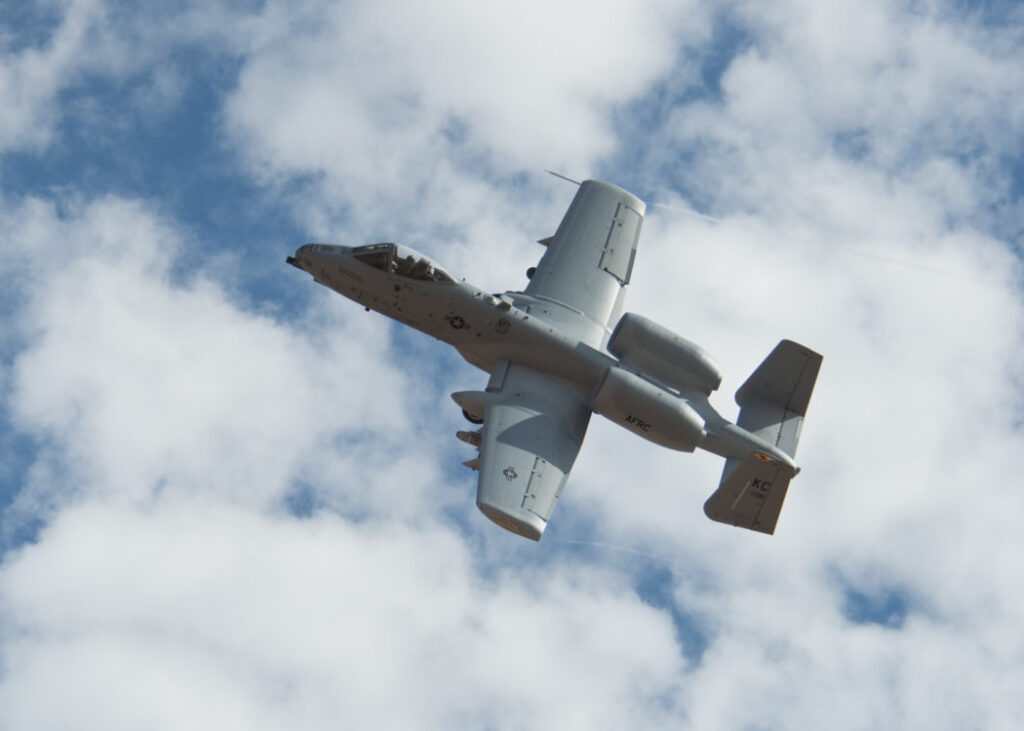
The A-10 was purpose-built to fill a capability gap in America’s airpower arsenal that had nothing to do with engaging enemy airplanes. After decades of focus on building faster, higher-flying fighters and bombers for a potential nuclear war with the Soviet Union, America found itself with no aircraft that were slow-moving, low flying, and resilient enough to be really effective at Close Air Support (CAS) in Vietnam. The Air Force’s jets simply couldn’t fly slowly enough to spot targets in dense jungle, didn’t have the fuel to make multiple passes, and weren’t resilient enough to absorb much in the way of enemy gunfire.
And that’s where Fairchild Republic came in with a design for an unusual aircraft that prized resiliency, redundancy, and function over all else. It was nearly as long as it was wide, and the fuselage was little more than a massive 30mm rotary cannon with a cockpit stuck on top. Two General Electric TF34-GE-100A turbofans engines were mounted high on the fuselage to protect them from sucking in dirt and debris on austere airstrips near the fight, and internally, redundant hydraulic systems and a titanium armor “tub” shielded the pilot and control systems from small arms fire.

Related: AMERICA COULD HAVE HAD THIS FLYING TANK INSTEAD OF THE APACHE
The result was a jet with practically unparalleled toughness, the ability to unleash 3,900 depleted uranium 30mm rounds at a target per minute, and a turn radius that would make any modern fighter blush. All that comes at a cost, however. The A-10 is a big jet without big power. A-10 pilots often joke that it really only has three settings: off, taxiing, and max power. Pilots from other aircraft can be even crueler, often kidding that the A-10 is so slow that it runs the constant risk of bird strikes… from behind.
Even the most modern A-10C, with updated cockpits and the ability to carry and leverage more munitions than ever, aren’t particularly well suited for a fight with most fighters in service today. It simply wasn’t built for it… but with America pivoting back toward great power competition and the A-10 slated to remain in service until the 2040s, this CAS champ is once again facing the possibility of having to square off with jets that were built specifically to hunt down and kill planes that can move a lot quicker than the Warthog does.
A-10 pilots learn how to leverage the plane’s unique skills in a dogfight

Most operational A-10 pilots don’t put much thought into dogfights. While we tend to think of combat aircraft in the individual sense, America leverages them as pieces of a broad combat strategy. In other words, the U.S. plans its operations around leaning into the strengths of different platforms and avoiding their weaknesses. As such, A-10s often operate in concert with air superiority fighters like the legendary F-15 Eagle, who are responsible for engaging enemy fighters before they have a chance to square off with any slow-moving Warthogs.
But as famed writer and former F-14 Radar Intercept Officer Ward Carroll pointed out in our discussion about speed versus stealth in 21st-century dogfighting, big wars against developed nations get messy. And in that mess lies the ever-present chance that things aren’t going to go exactly as planned. With dozens or even hundreds of aircraft in a fight, it’s entirely possible that a few enemy fighters might make their way past an A-10’s air superiority teammates. If that were to happen, the low-and-slow Warthog would certainly have its hands full… but that’s not to say that it wouldn’t stand a chance.
Twice each year, the Air Force sends its best A-10 pilots to Weapons School, where they learn advanced tactics they can bring back to their respective wings to teach the rest of the force. While you might think A-10 pilots would jump straight into delivering firepower to ground targets, they actually start with BFM.
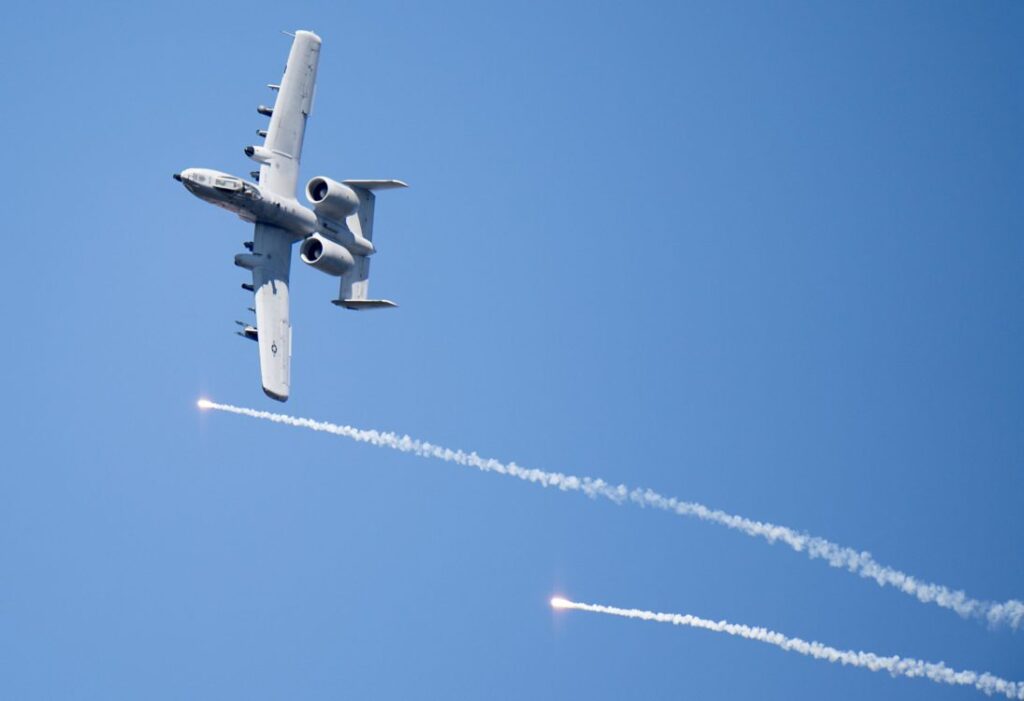
“BFM is a mission set that A-10 guys hopefully never have to use, because the theory is that you’re doing it in self-defense. The F-15s, or other Defensive Counter Air jets, should be on top of us, keeping all that stuff out of our way,” Retired Colonel Denny “Gator” Yount told The War Zone in an excellent feature published earlier this year.
“But if you get a ‘leaker’ [an enemy fighter that gets past the DCA] you need to train how to survive with the two AIM-9M Sidewinders and the ECM [AN/ALQ-131 electronic countermeasures] pod. These are the only things that stay on the airplane if you hit the big red button to punch off the stores.â€
If a “leaker,” or enemy fighter, does manage to get through, they’ll be in for a surprise. As American fighter pilots learned firsthand over Vietnam, being slow and maneuverable can work out in a gunfight against fast-moving jets. While the A-10 can’t outrun a fighter, it can outturn them.

“Most pilots of other types didn’t really understand our strengths until they had fought us a few times. Regardless of their turn rate, the best turn radius will get the first shot opportunity. At the corner, our turn radius was about 1,700 feet, and when I’m almost dead out of energy it’s about 2,100 feet — that’s not very big at all,” Yount explained.

Related: WHY THE NAVY NEVER PUT THE F-22 ON AIRCRAFT CARRIERS
The only fighter in Uncle Sam’s arsenal that could compete with that is the thrust-vectoring F-22 Raptor, and it would have to slow down to around 300 knots to do it, eliminating its speed advantage against the A-10 (though the F-22 could put a lot more power down when compensating). Remember, dogfights don’t have to play out over full minutes like we see in the movies. In fact, if things go well for one pilot (or really poorly for the other) a dogfight might last exactly how long it takes the two jets to complete a single loop after the merge (where they meet head-on).
Put simply, the A-10’s tight turn radius allows it to orient its nose at the enemy fighter faster than the enemy can get its guns pointed back at the A-10. To make matters worse for the fighter, the incredibly powerful 30mm GAU-8 the A-10 is packing can shoot an aircraft down from far further than the 20mm cannons commonly found on other fighters.
“So, even if they can out rate me, my gun can cross their nose before they can come around,” Yount explained.
“They have to respect that gun — which means they have to jink out of the way, which in turn presents some opportunities. If you put an A-10 in that close turning fight, we do very, very, well.”
A-10s carry two AIM-9M Sidewinders just in case a dogfight breaks out

As powerful as the GAU-8 is, the Warthog has other tools to help it win a fight with an opposing jet. In case of a dogfight, the A-10 also carries a pair of AIM-9M sidewinder missiles. AIM-9s are infrared-guided weapons with a range of 22 miles, giving the Warthog the punch it needs to engage an enemy fighter at a distance.
The combination of the A-10’s tight turn radius and AIM-9s makes for a frightening one-two punch for aggressive enemy fighters. If an enemy jet finds itself in close quarters with an A-10, its left to choose between two difficult options: You can try to out-turn the A-10 and fire your weapons before it can, or you can turn tail and run from the BRRRT. The problem is, if you turn and run, you’re flying right into the heat-seeking Sidewinder’s trap.
“If they get into the turning fight with us they deplete a lot of energy,” explained Yount. “Then they want to bug out, light the afterburner and get away — but all that does is make my AIM-9 lock-on alarm scream louder!”
Related: DOGFIGHTING AT 9GS: LIKE AIMING ‘THROUGH A TOILET PAPER ROLL‘
A-10s scored two Air-to-Air kills against helicopters in Desert Storm

While no A-10 pilot has managed to shoot down an enemy fighter in combat, the platform does have a few notches in its belt for downing enemy aircraft. During the Persian Gulf War, A-10s found renewed life after more than a decade of stagnating under its counter-Soviet role. In just forty days (the extent of the Persian Gulf War), the A-10 racked up an astonishing 987 kills against enemy tanks, 926 against enemy artillery pieces, 1,355 against other combat vehicles, 10 against enemy fighters on the ground, and two against airborne enemy helicopters.
The first of those shoot-downs can be credited to Air Force Capt. Bob Swain, who managed the kill in perfect Warthog form, using the GAU-8 Avenger, rather than his Sidewinder missiles.
“I noticed two black dots running across the desert that looked really different than anything I had seen before,” Swain explained in 1991. “They weren’t putting up any dust and they were moving fast and quickly over the desert.”
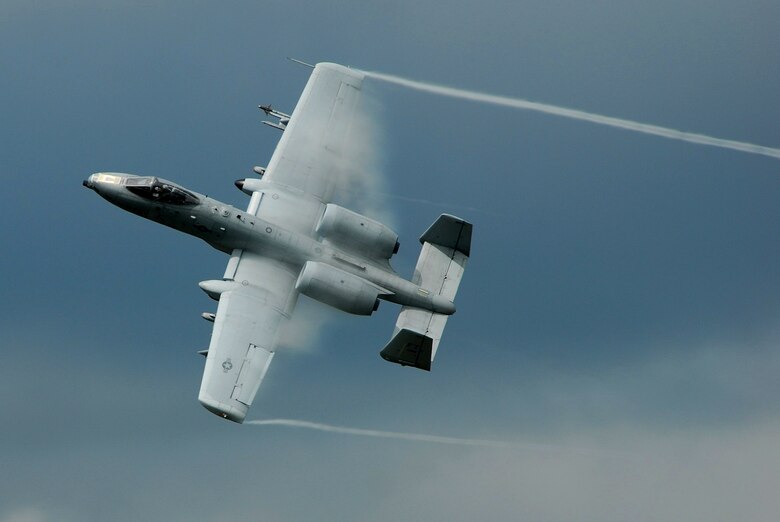
As Swain realized the black dots were indeed helicopters, one peeled off to the North and got away. The other headed south with Swain following behind. Because of the low altitude the two were flying at, Swain couldn’t get a lock on the helicopter with his AIM-9M, so he switched the aircraft back out of air-to-air mode and lined the MI-8 up in the “funnel” displayed in the A-10’s heads up display. Under normal circumstances, the HUD funnel shows an A-10 pilot where his bullets will likely track, though it gets more complicated in a dogfight.
“I started firing about a mile away,” Swain said. “Some of the bullets ran through him, but we weren’t sure if it was stopped completely. So I came back with the final pass, hit it and it fell apart.”
“On the final pass, I shot about 300 bullets at him. That’s a pretty good burst. On the first pass, maybe 75 rounds. The second pass, I put enough bullets down, it looked like I hit with a bomb.”
Ultimately, the A-10 Thunderbolt II was built to do a job that had nothing to do with winning a dogfight, but the Warthog has been defying expectations since its very inception; finding new purpose after the fall of the Soviet Union, surviving retirement again and again, and most impressive of all, returning safely after being positively riddled with holes from enemy fire. It seems only fitting that it would defy expectations yet again in the realm of air-to-air combat.
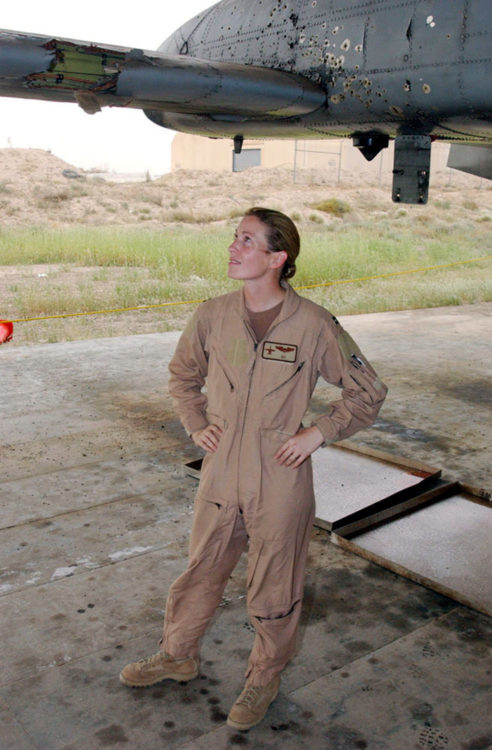
Because winning a fight isn’t always about who has the fastest jet or the most powerful missiles. Sometimes it might come down to nothing more than one tight loop and a veritable laser-beam of depleted uranium 30mm rounds.


